Ivanpah Valley: Three Solar Projects
May 22, 2015 - San Bernardino County CA and Clark County NV - Our photos this month showing how largescale solar energy projects fragment Mojave Desert ecosystems: Ivanpah Solar Electric Generating System, Stateline Solar Farm, and Silver State South Solar Farm, >>here.
Judge Rules Against Defenders of Wildlife and Tortoises on Silver State South Solar Project
April 1, 2015 - Yesterday a California federal judge ruled that the Bureau of Land Management and the U.S. Fish and Wildlife Service did not violate the Endangered Species Act while working toward approval of the 2,400-acre First Solar project in Ivanpah Valley in southern Nevada.
Defenders of Wildlife had filed suit in March of 2014 over tortoises on both the Stateline and Silver State South Solar Projects on either side of the border in Ivanpah Valley. It is unclear what the judge decided on Stateline. U.S. District Judge Michael W. Fitzgerald denied the group's motion for summary judgment and approved the defendants' cross-motion for summary judgment.
See (subscription required to read full article):
http://www.law360.com/articles/637570/first-solar-project-doesn-t-jeopardize-protected-tortoise
Grading of the Desert Begins
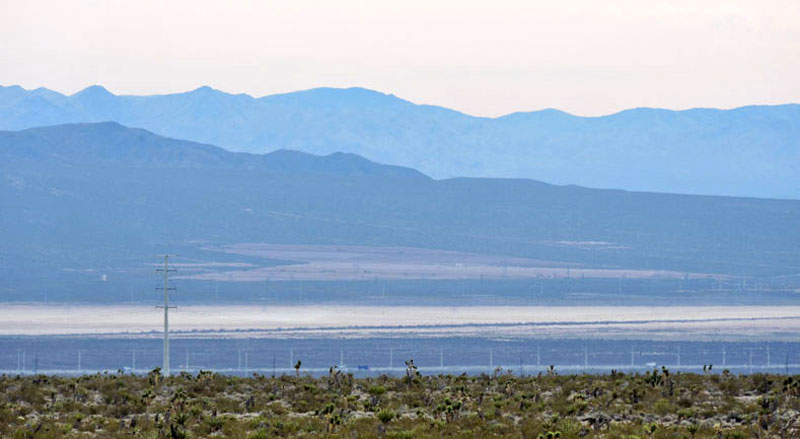
^View looking southward from Jean NV across Roach Dry Lake in Ivanpah Valley to the new grading of desert on the sloping alluvial fan in the distance, where solar panels will be constructed.
January 22, 2015 - About 1,000 acres have been bulldozed for the Silver State South Solar Farm and another nearly 1,000 acres have been bulldozed for the nearby Stateline Solar Farm as of this week. These projects are being constructed with 100 percent grading of desert ecosystems and tortoise habitat. All in all, now with the Ivanpah solar power towers, about 12 square miles of living desert habitat have been sacrificed for largescale solar projects in Ivanpah Valley, CA and NV.
First Solar Hits Another Desert Tortoise Jackpot! 152 Relocated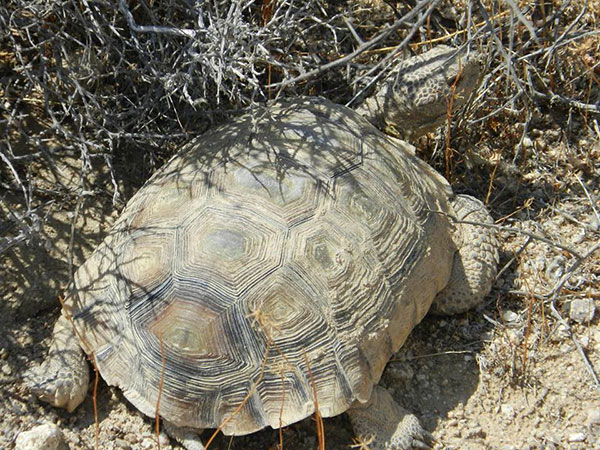
December 16, 2014 - Clark County NV - Most of the desert tortoises have been cleared from the 2,500 acre Silver State South solar project located in the Ivanpah Valley near Primm, Nevada. Now that the season is over, the total numbers are in. A total of 152 desert tortoises have been dug up and removed from the Right of Way for this project. 63 large (adult over 160 millimeters shell length) tortoises and 89 small (juvenile and subadult) have been relocated off of the site. There is still a section that needs surveyed and there will be 5 meter transect surveys continuing this spring. The Bureau of Land Management was quick to tell us that there have been no mortalities yet, but the clearance was just completed in November. The animals are hibernating now. Fence pacing and predation would occur next spring. A summary of the numbers to date for the Silver State South solar project desert tortoise translocation is in this pdf.
Solar Scorecard Released by Silicon Valley Toxics Coalition
Novemebr 23, 2014 - On November 11 the Silicon Valley Toxics Coalition (SVTC) today released its fifth annual Solar Scorecard, ranking the world’s largest solar companies on their efforts to improve their environmental impacts.
From their website: for over three decades, SVTC has been a leader in encouraging electronics manufacturers to take lifecycle responsibility for their products. This includes protecting workers from toxic exposure and preventing hazardous e-waste dumping in developing countries like India, Ghana, and China that lack the proper infrastructure to protect workers and the environment. SVTC also seeks to stop the practice of sending e-waste to U.S. prisons for dismantling, which results in toxic exposure to inmates.
The Scorecard is a resource for consumers, institutional purchasers, investors, installers, and anyone who wants to purchase photovoltaic (PV) modules from responsible product stewards. The Scorecard reveals how companies perform on SVTC’s sustainability and social justice benchmarks to ensure that the PV manufacturers protect workers, communities, and the environment. The PV industry’s continued growth makes it critical that action be taken now to reduce the use of toxic chemicals, develop responsible recycling systems, and protect workers throughout global PV supply chains. Many PV companies want to produce truly clean and green energy systems and are taking steps to implement more sustainable practices. We note First Solar gets a zero for biodiversity suatainability.
Silver State South Solar Farm Water Needs
October 24, 2014 - “Renewable” energy? “Sustainable” energy? Water is now being used several times a day to control dust for construction of the 2,427 acre Silver State South Project in Ivanpah Valley on the Nevada/California border. While this water is said to recharge, it should be noted that many desert aquifers are composed of fossil aquifers from much wetter climates in the past. The project proponent, First Solar, claims they will use only 200 acre feet of water per year, but the same company is requesting an additional 50 acre feet of water to complete their Desert Sunlight Project in Riverside County, California. In our experience, solar developers usually underestimate their water use in the review process. The Silver State South project is being built on significant desert tortoise linkage habitat. More on the project here:
http://www.blm.gov/nv/st/en/fo/lvfo/blm_programs/energy/Silver_State_Solar_South.html
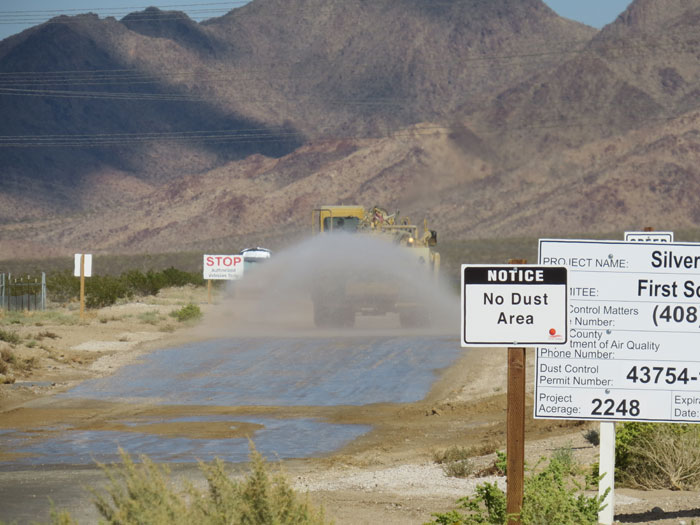
Large Numbers of Tortoise Moved at Silver State South Solar Project
July 23, 2014 - The Bureau of Land Management informed us in a personal communication today that biologists have found and removed a total of 38 desert tortoises from First Solar's Silver State South Solar Farm in eastern Ivanpah Valley, Clark County NV, within view of the three solar power towers of the first Ivanpah solar power plant in adjacent California. Small tortoises accounted for 21 of the total (under 160 millimeters), and 17 were large (over 160 mm). Tortoises were moved to recipient sites (where 15 large tortoises were found to be resident)
The numbers for Silver State South Phase 1 translocation: 13 transmittered/retransmittered tortoises from Phase I this spring, on approximately 700 acres cleared of tortoises for fence installation. Fifteen Phase II tortoises have already been transmittered (mainly retransmittered) this spring.
There are about 1,700 acres remaining to be cleared in Phase II.
First Solar in Action: Tortoises in Ivanpah Valley Face the Beginning of Destruction Today
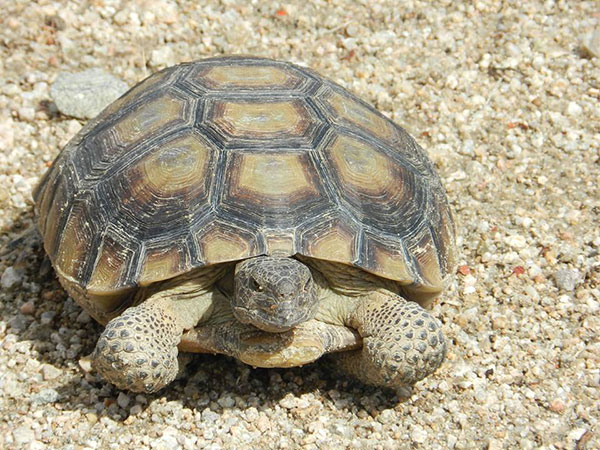
April 4, 2014 - This Friday, First Solar will start digging threatened desert tortoises out of their burrows on about 2,000 more acres of good quality habitat in Ivanpah Valley, California and Nevada. Then the bulldozers will grade the desert ecosystem here to make room for photovoltaic panels that should be going on urban settings. The Interior Department approved two more massive pubic land photovoltaic projects on a critical linkage habitat for the threatened desert tortoise, on public land. The projects are called Silver State South and Stateline.
Defenders of Wildlife Sues to Protect Ivanpah Valley
March 9, 2014 - Defenders of Wildlife went to the courts on March 6 over the approval by Bureau of Land management of the Stateline and Silver State South solar projects that would block tortoise connectivity in Ivanpah Valley, CA. Defendents were named as Sally Jewell, Secretary of the Department of the Interior, Daniel Ashe, Director of the U.S. Fish and Wildlife Service, and Neil Kornze, Director of the Bureau of Land Management.
http://www.defendersblog.org/2014/03/two-many-development-projects-ivanpah-valley/
Stateline and Silver State South Solar Projects Approved
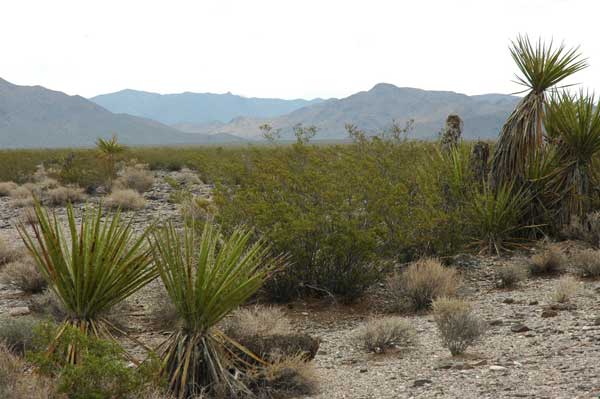
^Mojave yuccas and creosote desert rich with life to be bulldozed and shredded.
February 19, 2014 - Today Secretary of the Interior Sally Jewell announced the approval of two additional solar energy projectsin Ivanpah Valley in California and Nevada, on high quality desert tortoise habitat that will block genetic connectivity between populations in the north and south. US Fish and Wildlife Service had recommended against buolding more largescale solar projects here to maintain tortoise movement corridors, and many environmental groups protested the projects (including Basin & Range Watch).
The 300-megawatt Stateline Solar Farm Project will be built in San Bernardino County, California, on approximately 1,685 acres of public land located two miles south of the California-Nevada border. The second project is the 250-megawatt Silver State South Solar Project located east of Primm, Nevada on approximately 2,400 acres of public land. Both projects are being developed by First Solar and have power purchase agreements from Southern California Edison for 20 years.
Bureau of Land Management Principal Deputy Director Neil Kornze stated, “These solar projects reflect exemplary cooperation between the Bureau of Land Management and other federal, state and local agencies, enabling a thorough environmental review and robust mitigation provisions. Secretary Jewell’s commitment to a landscape-level approach represents a responsible balance between the need for renewable energy and our mandate to protect the public’s natural resources.”
Even though First Solar agreed to reduce the size of the projects, these will still amount to a significant amount of Mojave Desert ecosystems being bulldozed and graded flat, removing 100% of vegetation (not mowed as in the adjacent Ivanpah Solar Generating System design). BLM will expand the nearby Ivanpah Desert Wildlife Management Area by more than 20,000 acres. Basin & Range Watch and the Desert Tortoise Council had advocated for preservation of a much larger area for tortoises, and no more solar projects in this valley.
“As we implement the President’s Climate Action Plan to generate jobs, cut carbon pollution and move our economy toward clean energy sources, we need to do so in a way that takes the long view and avoids or minimizes conflicts with important natural and cultural resources,” said Jewell.
We disagree that this minimizes conflicts with natural and cultural resources (the valley is in the homeland for the Chemehuvi Tribe), but is rather a very poorly sited project in one of the densest tortoise populations left in the desert.
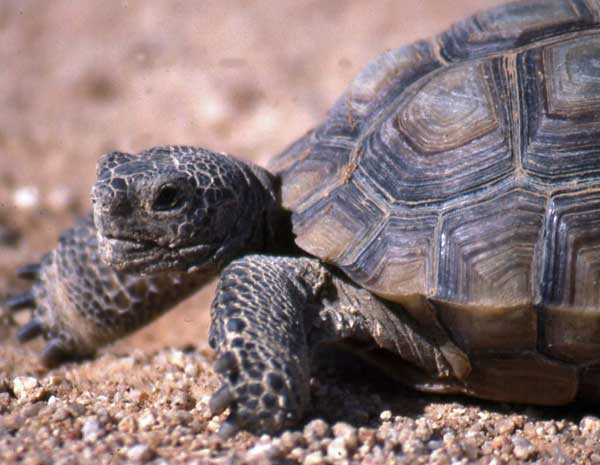
Defenders of Wildlife Sues Over Silver State and Stateline Solar Projects
November 12, 2013 - A big thank you to the Defenders of Wildlife for stepping up and defending the desert tortoise in Ivanpah Valley from big solar energy sprawl. The national environmental organization announced its lawsuit on it's blog today, against Bureau of Land Management, US Fish and Wildlife Service, and the Interior Secretary over the two new solar projects slated for the Ivanpah Valley. Those are the Stateline Solar Farm and the Silver State South Solar Farm totaling about 5,000 acres.
See the Defenders of Wildlife Blog: http://www.defendersblog.org/2013/11/adding-ivanpah/
Biological Opinion for Silver State South and Stateline Solar Projects
October 20, 2013 - On September 30, the US Fish and Wildlife Service completed its Biological Opinion, combined for the Silver State South and Stateline solar projects in Ivanpah Valley, on either side of the California-Nevada border. The Biological Opinion gives guidelines for trying to avoid significant impacts to the Federally Threatened Mojave desert tortoise, based on review of Bureau of Land Management right-of-way grants.
The problem, however, is that these two large-scale photovoltaic projects will devastate the tortoise population in this high-quality area, contributing to habitat destroyed by the Ivanpah Solar Electric Generating System (ISEGS) already under construction. Important genetic connectivity corridors through the valley will be whittled down to an all-too narrow slice of desert between the industrial project and steep mountains.
An upper range estimate of the number of adult tortoises that will have to be dug up out of their burrows and translocated for the Silver State South project is 115. For Stateline 94 adult tortoises are estimated to reside in the project proposal footprint. This is in addition to hundreds more juveniles, hatchlings, and eggs.
1,136 adult, juvenile, and hatchling tortoises are estimated to have been on the Ivanpah BrightSource project site. USFWS elevated the Ivanpah Valley tortoise density to 15 adults/square mile, up from 10/square mile before ISEGS. This is some of the highest density for a population anywhere. 25 tortoises were killed or found dead in translocated populations, resident populations nearby, and at control sites that were more distant and used to compare with translocation numbers. Coyote predation, over-heating, vehicle strike, a trampling by livestock, and unknown causes are listed.
Most tortoises will be moved over the fence and re-located just outside the project area in adjacent habitat for both projects (most juveniles and hatchlings are crushed and killed during construction as they are so small as to be difficult to find). But this will be problematic since both areas have previously translocated tortoises already squeezed into smaller areas: ISEGS (we believe around 130 adults were translocated) and Silver State North (with an estimated 35 tortoises total on the project, six adults translocated).
When these adjacent areas fill up with tortoises over the estimated carrying capacity of the desert habitat, new areas slightly further away will be used to translocated tortoises into Ivanpah Valley and also the Puite-Eldorado area of Nevada.
Download the 3.9 MB Biological Opinion pdf >>here.
First Solar's Silver State South Solar Farm Final Environmental Impact Statement Released
September 21, 2013 - This project will destroy some of the best tortoise habitat we have seen, plus a connectivity corridor linking genetic populations. We were hoping to have the entire alluvial fan designated as an Area of Critical Environmental Concern but instead the solar project will be carved out of it in prime habitat.
From the Bureau of Land Management: Notice of Availability of the Final Environmental Impact Statement for the Silver State Solar South Project, Clark County, NV
“The BLM Preferred Alternative is smaller in area than other analyzed project alternatives and reduces electricity generation capacity to 250 MWs. The BLM Preferred Alternative would disturb up to 2,427 acres of Federal land entirely within the footprint of alternatives analyzed in the Draft Supplemental EIS/Proposed RMP Amendment, and thus involves no new areas of effect. The BLM Preferred Alternative also includes a 31,859-acre area for designation as an ACEC and management prescriptions that would be required for the designated ACEC.”
http://www.blm.gov/nv/st/en/fo/lvfo/blm_programs/energy/Silver_State_Solar_South.html
Environmental Review Documents Due Out
October 29, 2012 - The Draft Environmental Impact Statement for the Stateline Solar Project in Ivanpah Valley, CA will be coming out in about two weeks, according to Department of Interior officials we talked to. This will add to the cumulative impacts to the tortoise-rich valley in addition to the Silver State South solar project also in review.
The Biological Report is out for the Silver State Project
August 3, 2012 -The highest desert tortoise densities are up to 50 tortoises per square mile. The average density for the site is eight per square mile. It looks like we may have another desert tortoise mass clearance like there was for the Ivanpah Project. Download the report >>here
Silver State South
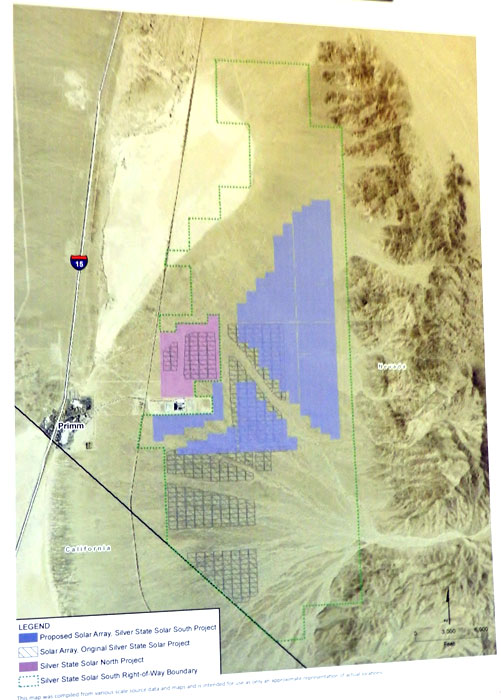
^In purple, the BLM preferred alternative of placement of the Silver State Solar Farm South project footprint within the large Right of Way. The pink represents the current Silver State North project approved and under construction.
October 11, 2011 - Scoping meetings were held by the Bureau of Land Management in Las Vegas, the Primm Gold Course, and Jean in late September, to collect public comments about the large second phase of First Solar's photovoltaic project in eastern Ivanpah Valley, Clark County, Nevada.Photos of the project site >>here.
The 50 megawatt Silver State North project is under construction now.
The 400 MW Silver State South project would include a 13,043 acre Right of Way of Federal land managed by the BLM. The Bureau of Land Management preferred alternative footprint would be about 4,000 acres of photovoltaic panels, located farther north on the alluvial fan below the Lucy Gray Mountains. First Solar's preferred alternative was not shown except to indicate the older version of the Silver State layout on the map.
BLM will prepare a supplemental environmental impact statement (SEIS), as well as a proposed amendment to the Las Vegas Resource Management Plan (LVRMP). Comments are due October 31, 2011.
First Solar said it will raise private financing for the Silver State South project, as it did not receive a Department of Interior loan guarantee before the program ended at the end of September.
OHV recreationists questioned how the proposed project would impact their routes. Flooding could also still be a problem for the solar panels on the active alluvial fan. Rare plants such as White-margined penstemon (Penstemon albomarginatus) may be impacted.
The power from Silver State North will connect to NV Energy; that from Silver State South will go to California.
The July 2011 Plan of Development does not include a biological appendix, and simply refers the reader to previous biological surveys for the alternative located further south on the central fan. We beleive significant populations of tortoise and rare plants could also inhabit the northern part of the fan on which the BLM preferred alternative would be placed (see map). Updated biological surveys need to be undertaken.
Only written comments will be accepted and may be mailed to the BLM, Southern Nevada District, Renewable Energy Project Manager, 4701 N. Torrey Pines Drive, Las Vegas, NV 89130, or emailed to SilverStateSouthEIS@blm.gov.
Silver State Phase 1 Approved
October 12, 2010 - Secretary of the Interior Ken Salazar today approved the First Solar, Inc. Silver State North Solar Project, the first large-scale solar energy project on U.S. public lands in Nevada. The 50-megawatt (MWAC) 60 (MWDC) solar facility and associated infrastructure will be built in the Ivanpah Valley, 40 miles south of Las Vegas.
Phase 1 of Silver State will consist of the construction and operation of a solar photovoltaic plant, including associated facilities, on 618 acres of public lands. The electricity will be sold to the Nevada market via a Power Purchase Agreement with NV Energy; and will connect into NV Energy’s existing electrical grid.
The 50 MW Silver State North Solar photovoltaic facility is the first project to be permitted by the BLM at the site. First Solar plans to construct up to an additional 350 MW at the site, which will require additional supplemental environmental review and analysis.
The project was in such rich tortoise habitat, with many tortoises found, the First Solar and BLM agreed to scale back the project to only Phase 1 in the northern part of the original application.
http://www.blm.gov/wo/st/en/info/newsroom/2010/october/NR_10_13_2010.html
Salazar Expected to Sign Approval of Project on October 12

October 7, 2010 - Interior Secretary Ken Salazar will most likely sign the Right-of-Way approval for the 400 megawatt Nextlight Silver State photovoltaic project next week, according the the Las Vegas office of the Bureau of Land Management. This will present a cumulative blow to the Desert tortoise, which is abundant on the alluvial fan where the Nevada project is slated. The solar arrays would disturb 2,575 acres. The ROW application covers approximately 7,925 acres of federal BLM-managed lands.
Across Ivanpah Valley on the California side, Salazar today approved the 3,471-acre Ivanpah Solar Electric Generating System project, which is also on high-quality tortoise habitat. Both projects are in the Northeastern Mojave Recovery Unit of the tortoise, which has been experieincing recent declines and even population crashes. These large acreages of desert habitat will add to the fragmentation of this genetic population.
Tortoises In Trouble
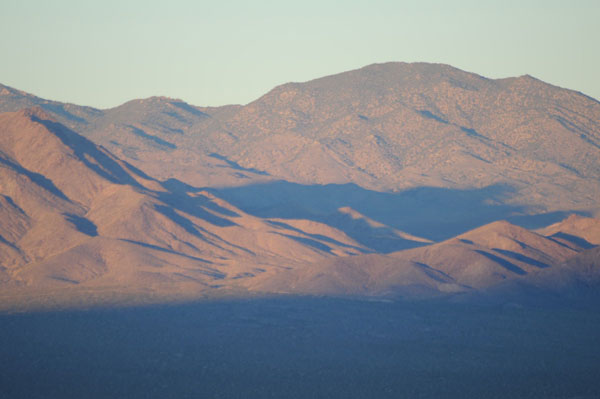
^Sunset illuminates the top of the fan where Silver State would be built, below the Lucy Gray Mountains and McCullough Mountains, Nevada.
September 17, 2010 - Primm, Nevada -- The Northeastern Mojave Recovery Unit of Desert tortoise is already declining, yet several large-scale solar projects are planned for tortoise habitat.
The 1994 Recovery Plan delineates the Northeastern Mojave Recovery Unit to occur primarily in Nevada, but it also extends into California along the Ivanpah Valley and into extreme southwestern Utah and northwestern Arizona.
Based on the best available information, approximately 123 sub-adult and adult desert tortoises are anticipated to be captured and translocated during the life of the Silver State project. The US Fish and Wildlife Service estimates that "no more" than 97 hatchling desert tortoises will be accidentally injured or killed.
Die-offs have been occurring in this genetic lineage of Desert tortoise. Recent analysis indicated large areas in the Piute-Eldorado Valley, in part of the Northeastern Recovery Unit, where there were carcasses but no live desert tortoises. For this entire area in 2001, there were 103 miles of transects walked, and a total of 6 live and 15 dead desert tortoises found, resulting in a live encounter rate of 0.06 desert tortoises per mile of transect for this area. This encounter rate was among the lowest that year for any of the areas sampled in the range of the Mojave desert tortoise
Prior to construction, clearance surveys and translocations would be conducted for desert tortoise on each construction area in accordance with current Service protocols and an approved desert tortoise relocation/translocation plan. The Service currently refers to all movement of desert tortoises as translocations regardless of the distance. Consequently, in this biological opinion, the Service uses the term translocation exclusively.
The proposed project would be constructed in three phases. Phase I would consist of the construction of a 60-megawatt (MW) solar plant and associated facilities. Phase II would include construction of a 140-MW solar plant and associated facilities. Phase III would construct the remaining solar panels to produce 200 MW and infrastructure to complete the project. If BLM approves the ROW grant by late 2010, initial delivery of power is scheduled for mid-2011 (April- July).
The project ROW applications comprise a total of 7,925 acres in desert tortoise habitat; however, actual footprint for the project and related facilities would be approximately 2,966 acres. Facilities and equipment inside a fenced perimeter would include: an operation and maintenance facility, with switchyards, the solar field, transmission lines, and access ways; outside the fenced perimeter: access roads, transmission lines, stormwater control berms, and a firebreak.
Initial grading work would use track-driven excavators, graders, dump trucks, and end loaders, in addition to the support pickups, water trucks, and cranes. It is anticipated that approximately 20 pieces of this type of large equipment would be onsite for the first year of construction for grading. Within each area of construction, NextLight would till and compact the soil, removing all vegetation, prior to construction.
The project would use crystalline silicon or thin film PV technology mounted on either single- axis trackers or fixed-tilt structures. The construction of the solar field would proceed in 1-MW blocks. Each block would be approximately 700 feet by 400 feet and would contain solar panels, an inverter, and step-up transformer. Support foundations for PV structures would be composed of galvanized steel piers driven to a depth of 8 to 12 feet. The solar field and support facilities perimeter would be secured with chain link metal-fabric security fencing. Controlled access gates would be located at the site entrance. Access gates would also be located at specific locations along the perimeter road to allow maintenance and security crew access to all portions of the project site.
Four existing natural washes that traverse the project site would be reinforced with five berms made of compacted soil and lined with aggregate rock. Each berm would be constructed outside the perimeter fence. The berms would be constructed to a height of 3 to 5 feet above grade with a top width of approximately 15 feet. Phase 1 would not require drainage control facilities because the area is level and is not susceptible to erosion; however, Phase 2 and Phase 3 require drainage control berms. Following completion of the drainage structures, areas disturbed during construction would be restored in accordance with an approved restoration plan. The drainage control berms would occupy approximately 17.7 acres. Construction is anticipated to disturb an additional 11 acres.
Water would be supplied by on-site wells under a long-term contract from the Las Vegas Valley Water District. Peak use would be during construction for dust suppression. Up to 600 acre-feet would be used for construction, with no more than 200 acre-feet a year for 4 years. Water requirements for operations and maintenance would be 21 acre-feet per year for 30 years. Impervious areas of the proposed project would only cover 0.05 percent of the Ivanpah Valley groundwater basin, most of which is undeveloped.
(From the Biological Opinion)
"Barbie Fan"
August 27, 2010 - Because it is too perfect an alluvial fan. "Take a look at the recent drainage courses on the fan and appreciate how a relatively small change in the position of a major distributary channel could convey a flood entirely to either state, or both. A dilemma for water lawyers, possibly. Certainly a potential dilemma for the major airport that has been planned (now on hold for economic reasons)..."
First Solar wants to construct a thin-film photovoltaic power plant on this fan.
See Pathological Geomorphology.
Flash Floods
August 18, 2010 - The National Weather Service in Las Vegas, Nevada, issued a Flash Flood Warning at 1:44 PM, for Ivanpah Valley in northeastern San Bernardino County. At 1:37 PM Doppler radar picked up very heavy rain from a stationary thunderstorm 10 miles southeast of Nipton. Over 3 inches of rainfall were estimated from this storm in a short period. The Service issued this warning:
IN DESERT TERRAIN THERE ARE HUNDREDS OF LOW WATER CROSSINGS WHICH ARE
POTENTIALLY DANGEROUS IN HEAVY RAIN. DO NOT ATTEMPT TO TRAVEL ACROSS
FLOODED ROADS. TURN AROUND...DONT DROWN. FIND ALTERNATE ROUTES.
We wonder what would happen to solar panels and heliostats proposed to be placed in these washes nearby at Silver State and the Ivanpah Solar Electric Generating System projects.
Silver State Moving Fast to Approval
August 12, 2010 - According to Bureau of Land Management, First solar/Silver State is hoping to do a tortoise clearance by September 15th. The final Biological Opinion and Translocation Plan are at US Fish and Wildlife Service for final review.
The Final Environmental Impact Statement and Record of Decision may be issued concurrently in early September, according to BLM's National Environmental Policy Act Handbook: the ROD cannot be filed for at least 30 days after the issuance of the FEIS, unless the decision is subject to 30-day appeal to the IBLA, in which case the FEIS and ROD can be issued concurrently. All the Fast-track projects are apparently subject to appeal to the IBLA, thus the ROD can be issued at the release of the FEIS, effectively allowing construction to begin without further public comment. Bypassing the IBLA is a strategic move to save time and prevent an appeal from delaying the approval of the proposed project past the American Recovery and Reinvestment Act subsidy deadline. The BLM action that would typically be open for an appeal to IBLA is the granting of a right of way for the project. The bypass strategy would likely involve the right of way grant being approved at the Department of Interior Secretary level rather than by a BLM field manager or even the BLM director. Since IBLA essentially works for the DOI Secretary, a decision to issue a right of way made at the DOI would not be subject to appeal. It would be the final decision of the DOI. The remaining recourse would be through federal court.
This is likely to happen also for the Ivanpah Solar Electric Generating System project and Imperial Valley Solar Project.
The project will be built in three phases, but the first phase would be on 800 acres on the northwest side next to existing transmission lines, reflecting the 50 megawatt Power Purchase Agreement with NV Energy so the first translocation will be on 800 acres. Tortoises would be translocated from this phase to just outside and adjacent to the project area. The translocation site for phase 2 and 3 would be just north Walking Box ranch, 800 feet higher than the project site. These phases of the project will be delayed by one to two years, however, because the recipient site must be thoroughly surveyed and studied before any translocation can occur.
Scoping Meetings
April 28, 2010 - Bureau of Land Management will hold public scoping meetings to get comments on its Draft Environmental Impact Statement just released. Public Comment Period - The publication of the NOA in the Federal Register begins the 45-day public comment period for the EIS. The notice includes specific information about the public comment period, including time frame, public meetings, and information about how comments may be submitted.
Public meetings will be held to review and comment on the Draft EIS. The meetings will be in an open house format with information available about the Draft EIS and the proposed project. The meetings are scheduled from 6 p.m. – 8 p.m. on May 11, 12 and 13 in Primm, Henderson, and Jean:
Tuesday, May 11, 2010: Primm Valley Resort and Casino, 31900 South Las Vegas Blvd., I-15S, Primm
Wednesday, May 12, 2010: M Resort Spa Casino, 12300 Las Vegas Blvd. South, Henderson
Thursday, May 13, 2010: Gold Strike Hotel and Casino, 1 Main Street, Jean
From BLM Las Vegas office. See our report >>here.
First Solar Buys NextLight
April 28, 2010 - First Solar paid $285 million in cash for NextLight Renewable Power, LLC. The acquisition includes a 1,100 MW solar project pipeline. The transaction represents another strategic step in First Solar’s expansion in the U.S. utility-scale power market, which began in 2007 with the acquisition of Turner Renewable Energy and continued with the acquisitions of solar project pipelines from OptiSolar in 2009 and Edison Mission Group in 2010.
See BusinessWire.com.
Draft EIS Out
April 16, 2010 - Primm, Nevada - If you are concerned about the desert tortoise, this should worry you. The Bureau of Land Management and the applicant NextLight plan on translocating about 200 desert tortoise to an area they refer to as a "depletion zone". It is north of Searchlight, Nevada, near Highway 93. That means that the tortoises that formerly inhabited the depletion zone vanished for some reason. Perhaps from highway predators. Putting 200 more there may actually not be a good plan. While it is in a Critical Habitat area it is also in a different recovery unit, meaning they will mix up the genetics of the population.
The latest information we have is that First Solar of Arizona may be the supplier of Cadmium-Telluride thin-film fixed photovoltaic panels for the project.
The Draft Environmental Impact Statement for the NextLight Silver State Solar Project came out today.
To ensure comments will be considered, the BLM must receive written comments on the Silver State Solar Project Draft EIS within 45 days.
The BLM will announce future meetings or hearings and any other public involvement activities at least 15 days in advance through public notices, local news media, and the BLM Web site at: http://www.blm.gov/nv/st/en/fo/lvfo.html.
ADDRESSES: You may submit comments by any of the following methods:
Web site: http://www.blm.gov/nv/st/en/prog/energy/fast-track_renewable.html.
E-mail: nextlight_primm_nv_sep@blm.gov.
Mail: Gregory Helseth, Renewable Energy Project Manager, BLM Pahrump Field Office, 4701 North Torrey Pines Drive, Las Vegas, Nevada 89130-2301.
FOR FURTHER INFORMATION CONTACT: Gregory Helseth, phone: 702-515-5173
702-515-5173 , e-mail: Gregory_Helseth@blm.gov.
NextLight Renewable Power, LLC applied to the BLM for a right-of-way on public lands to construct a solar photovoltaic (PV) plant facility approximately two miles southeast of
Primm, Clark County, Nevada. The facility is expected to operate for approximately 50 years. The proposed project would produce 400 megawatts (MW) of renewable energy.
The solar field and infrastructure would consist of single-axis tracker systems or fixed panels, an underground and overhead electrical power collection system, two step-up transformers, 230 kilovolt (kV) and 220 kV transmission lines, an operation and maintenance area, a switchyard, paved access and maintenance roads, flood and drainage controls, and a fire break.
The EIS analyzes three alternatives, including the no action alternative (Alternative 1) and two action alternatives. Alternative 2--the proposed action--would disturb up to 2,996 acres of land and would include the use of berms to reduce erosion. Alternative 3 would
disturb up to 3,669 acres of land and would employ an alternate drainage and flood control design to control erosion. Both action alternatives would use solar PV technology, although the specific types of arrays and trackers have not been determined at this time.
[Federal Register: April 16, 2010 (Volume 75, Number 73), Page 19990-19991, From the Federal Register Online via GPO Access wais.access.gpo.gov]
Preliminary Tortoise Surveys
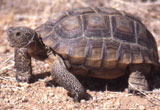
March 19, 2010 - Basin and Range Watch recently used a Freedom of Information Act request to obtain 2009 preliminary tortoise surveys for the NextLight Silver State solar site in Ivanpah Valley, a place where we have seen abundant sign of Desert tortoises.
The biological contractors estimated that there are 20 tortoises per square mile (high), although this was from a "presence/absence survey" which does not use rigorous density survey techniques. So there could be even more tortoises. Even 20 per square mile is over the qualifications to designate this area as Critical Habitat. The surveyors suggested that a suitable relocation site(s) would be to just move the tortoises to the side of the project. We think that is probably not a great idea.
NextLight needs to carry out more thorough surveys, as this area is extremely good tortoise habitat, currently undisturbed.
See the biological contractor report pdf >>here.
See also this excellent video The Heat Is On: Desert Tortoises and Survival, by Stephen M. Wessells and Steven E. Schwarzbach, prepared by the United States Geological Survey in cooperation with the U.S. Fish and Wildlife Service, >>here. The video mentions renewable energy threats to the tortoise, showing solar technology identical to that proposed for the NextLight site.
NV Energy Signs Power Purchase Agreement
February 19, 2010 -
NV Energy and NextLight Renewable Power LLC, have announced a 25-year contract for the purchase and sale of 50 MW (out of 400 total) of energy to be produced at NextLight's Silver State Solar Power photovoltaic facility near Primm, Nevada. The project will interconnect with NV Energy's Bighorn substation adjacent to the project site. The rest of the 400 MW has not yet been spoken for.
The Nevada Renewable Energy Act mandates 6 percent of the total renewable energy credits to come from solar resources. The long-term agreement stems from NV Energy's 2009 Request for Proposals for renewable energy and requires approval by the Public Utilities Commission of Nevada.
From discussions with the Las Vegas office of Bureau of Land Management, and Renewable Energy World.com
Scoping Comments Dedline Extended
September 17, 2009 -
BLM extended public comments before preparing its Draft Enironmental Impact Statement on the NextLight Projects. The new deadline is October 19, 2009. Comments may be submitted in writing to the Bureau of Land Management, Attn: Gregory Helseth, Renewable Energy Project Manager, 4701 North Torrey Pines Drive, Las Vegas, NV 89130–2301, NV 89049; by fax 702-515–5010 (attention Gregory Helseth); or e-mail to Nextlight_Primm_NV_SEP@blm.gov, or solar_millennium@blm.gov.

